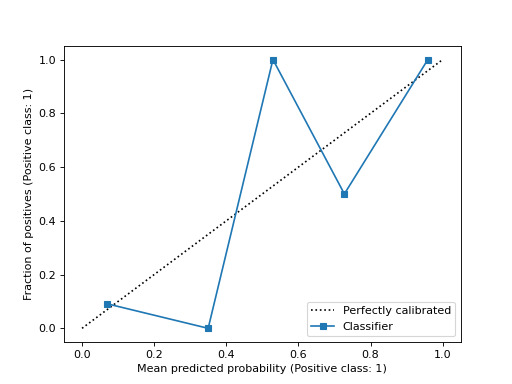本文簡要介紹python語言中 sklearn.calibration.CalibrationDisplay.from_predictions 的用法。
用法:
classmethod from_predictions(y_true, y_prob, *, n_bins=5, strategy='uniform', name=None, ref_line=True, ax=None, **kwargs)使用真實標簽和預測概率繪製校準曲線。
校準曲線,也稱為可靠性圖,使用來自二元分類器的輸入,並在 y 軸上繪製每個 bin 的平均預測概率與正類的比例。
額外的關鍵字參數將傳遞給
matplotlib.pyplot.plot。在用戶指南中閱讀有關校準的更多信息,並在 Visualizations 中閱讀有關 scikit-learn 可視化 API 的更多信息。
- y_true:形狀類似數組 (n_samples,)
真正的標簽。
- y_prob:形狀類似數組 (n_samples,)
正類的預測概率。
- n_bins:整數,默認=5
計算校準曲線時將 [0, 1] 區間離散化為的 bin 數。更大的數字需要更多的數據。
- strategy:{‘uniform’, ‘quantile’},默認='uniform'
用於定義 bin 寬度的策略。
'uniform':箱子具有相同的寬度。'quantile':bin 具有相同數量的樣本並取決於預測概率。
- name:str,默認=無
標記曲線的名稱。
- ref_line:布爾,默認=真
如果
True,繪製代表完美校準分類器的參考線。- ax:matplotlib 軸,默認=無
要繪製的軸對象。如果
None,則創建一個新的圖形和軸。- **kwargs:dict
要傳遞給
matplotlib.pyplot.plot的關鍵字參數。
- display:
CalibrationDisplay。 存儲計算值的對象。
- display:
參數:
返回:
例子:
>>> import matplotlib.pyplot as plt >>> from sklearn.datasets import make_classification >>> from sklearn.model_selection import train_test_split >>> from sklearn.linear_model import LogisticRegression >>> from sklearn.calibration import CalibrationDisplay >>> X, y = make_classification(random_state=0) >>> X_train, X_test, y_train, y_test = train_test_split( ... X, y, random_state=0) >>> clf = LogisticRegression(random_state=0) >>> clf.fit(X_train, y_train) LogisticRegression(random_state=0) >>> y_prob = clf.predict_proba(X_test)[:, 1] >>> disp = CalibrationDisplay.from_predictions(y_test, y_prob) >>> plt.show()
相關用法
- Python sklearn CalibrationDisplay.from_estimator用法及代碼示例
- Python sklearn CalibrationDisplay用法及代碼示例
- Python sklearn CalibratedClassifierCV用法及代碼示例
- Python sklearn CategoricalNB用法及代碼示例
- Python sklearn ConfusionMatrixDisplay.from_predictions用法及代碼示例
- Python sklearn ClassifierChain用法及代碼示例
- Python sklearn ComplementNB用法及代碼示例
- Python sklearn CountVectorizer用法及代碼示例
- Python sklearn ConfusionMatrixDisplay用法及代碼示例
- Python sklearn CompoundKernel用法及代碼示例
- Python sklearn ConstantKernel用法及代碼示例
- Python sklearn ConfusionMatrixDisplay.from_estimator用法及代碼示例
- Python sklearn ColumnTransformer用法及代碼示例
- Python sklearn CCA用法及代碼示例
- Python sklearn jaccard_score用法及代碼示例
- Python sklearn WhiteKernel用法及代碼示例
- Python sklearn VotingRegressor用法及代碼示例
- Python sklearn gen_batches用法及代碼示例
- Python sklearn ExpSineSquared用法及代碼示例
- Python sklearn MDS用法及代碼示例
- Python sklearn adjusted_rand_score用法及代碼示例
- Python sklearn MLPClassifier用法及代碼示例
- Python sklearn train_test_split用法及代碼示例
- Python sklearn RandomTreesEmbedding用法及代碼示例
- Python sklearn GradientBoostingRegressor用法及代碼示例
注:本文由純淨天空篩選整理自scikit-learn.org大神的英文原創作品 sklearn.calibration.CalibrationDisplay.from_predictions。非經特殊聲明,原始代碼版權歸原作者所有,本譯文未經允許或授權,請勿轉載或複製。
